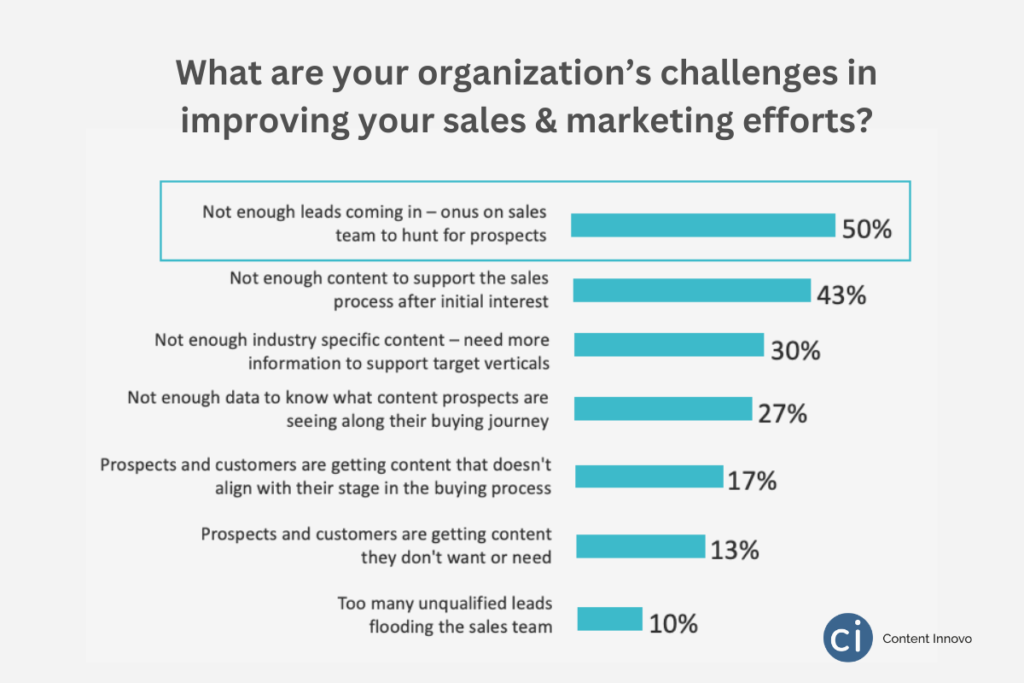The business-to-business (B2B) sales role is shifting. Yes, sales teams need to walk prospects through the many features and benefits of their company’s offering, but the job now requires a broader scope of relationship building, making connections, and thought leadership. HubSpot’s 2024 Sales Trends Report confirmed what we already know—sales professionals say selling has been harder this year than it was before. The report also noted that 82% of sales professionals say building relationships and connecting with people is both the most important part of selling and the most enjoyable part of their job.
As B2B content marketers, we know how targeted content can accelerate the buying cycle, propel prospects to action, and close a sale. A recent report from Prezentor showed that 95% of B2B buying decisions are directly influenced by content, yet 48% of sellers say they struggle with communicating value. This disconnect reflects the ongoing silos that plague marketing and sales teams, especially within larger organizations.
If you’re feeling this divide in your organization, you’re not alone. HubSpot found that only 30% of sales professionals say sales and marketing are strongly aligned at their company. As businesses navigate the labyrinth of B2B sales and marketing, this central issue looms large.
Put simply, sales are achieved faster and more efficiently when the sales and marketing teams are aligned. Marketing can help sales shorten long sales cycles with content that helps solve key concerns for customers, but they need the sales perspective to ensure content resonates and incites action.
Let’s walk through five of the top challenges in B2B sales and how you can overcome them with a strong content marketing program.
Challenge #1:
Generating More QUALITY B2B Sales Leads
Misalignment between sales and marketing teams can most often be seen in the way leads are generated (or not generated, as is frequently the case). We surveyed marketing and sales leaders and saw this impact clearly in their responses—their number one issue was generating enough leads of the right quality to support their sales efforts. This forces sales teams to spend more time hunting and prospecting, instead of starting their day armed with a set of warm leads who are ready to talk.

When the feedback loop between marketing and sales falters, the marketing team loses their ability to effectively generate and vet leads—and this dampens their capacity to empower B2B sales teams. And what happens then? Sales still has to meet their targets, so they take matters into their own hands, often generating content that may not align with the prescribed brand voice and guidelines. According to Prezentor, 76% of sales leaders are planning to invest in content creation. And this further sows the seeds of discord between the teams. Sales is wasting time and effort generating off-brand content, and marketing is wasting time and effort policing the sales team.
Solution: Bring Sales Insights into Marketing Personas
Marketing will attract more quality leads when armed with a robust set of buyer personas—customer “blueprints” spelling out their motivations, challenges, and goals. This is key to any successful content strategy. Marketers build buyer personas using many sources of data, but they don’t always get it right (for example, when incorrectly determining the “job” of a McDonalds milkshake) They need the right insights on their customers and prospects to build an effective persona—and in B2B, key insights are held by the sales team.
The sales team is more directly engaged with buyers on a daily basis. Through their conversations, the sales team learns more about buyer pain points and aspirations and plays a vital role in understanding the ideal customer. In addition, they can relay back important signals when these factors inevitably change and evolve over time.
When marketing and sales teams come together to build (and regularly tweak and refine) detailed buyer personas, they are more likely to get it right, focusing efforts on the correct decision-makers and influencers involved in the buying process. Marketing needs to ask, “What are buyers thinking and feeling?” and “How do we uniquely solve their problem?” Sales teams often hold answers to these crucial questions.
With more effective personas in hand, marketing is empowered to generate better content that draws in the right prospects, qualifies them, and delivers them warm to the sales team.
Challenge #2:
Optimizing the B2B Sales Cycle
B2B sales cycles are long, ranging from four to six months for “easier” sales to as long as 12-18 months for more complex, enterprise-wide solutions. This elevates the need for marketing and sales to work together throughout the sales cycle, rather than engaging in the traditional “handoff” once the lead is generated. The Harvard Business Review even declared that traditional B2B sales and marketing are becoming obsolete. It described an ongoing transition away from that handoff from digital to “human selling,” noting that buyers prefer to spend the majority of their time researching independently, with, on average, only 17% of their total buying time spent interacting directly with supplier sales teams (according to Gartner research).
So, for B2B sales teams to be successful, they need a lot of content, for a lot of stakeholders, for a long period of time to make a sale. And most marketing teams ARE producing a lot of content. Yet, according to Prezentor, 65% of sales content created by B2B organizations goes unused. What B2B organizations need is more effective content.
Solution: Map Your B2B Buyer Journey
Just as it’s vital to enhance accuracy in buyer personas, it is important to understand how each persona is involved in the buying journey. Especially in larger enterprises, stakeholders come in and out at different stages to provide input and influence the sales process. Each has individual needs and motivations that a sales team needs to address to secure their support.
When sales and marketing teams partner effectively to map the buyer journey, they gain key insights that help them understand the needs of important stakeholders at each stage. Marketing is then empowered to produce what we call intentional content (versus responsive content that’s created ad hoc to serve an immediate need).
The marketing team can ease the burden on the sales team considerably by creating the right content that supports each stakeholder at different stages of the B2B buyer journey. Or, even better, marketing can develop content that addresses stakeholder concerns before they voice them, thereby creating advocates and champions along the way to reduce friction and shorten the sales cycle.
Challenge #3:
Measuring ROI in a Complex B2B Buying Process
Today’s B2B buying process is far from linear. A complex digital sales cycle has many touchpoints, making ROI measurement difficult. Deciphering which sales or marketing action precisely impacted the warming of a lead or triggered a sale is rarely straightforward. Organizations often become paralyzed with data analysis, unable to attribute conversion to the right activities that influenced the buyer.
Viewing the customer journey through an individual touchpoint is shortsighted. Odds are a customer has touched your brand 30-50 times before you close a sale. The commonly used last-touch attribution model loses any context for what drove your leads (e.g., nurturing touches) to your product or service. What content did the prospect read at each stage in the buying cycle? Gaining an awareness of what the prospect and related stakeholders are consuming outside of direct conversations with a sales team will contribute valuable information to augment the sales strategy.
Solution: Develop Robust CRM That Tracks Cross-Channel Touchpoints
A comprehensive CRM system that tracks prospect and customer touchpoints and content consumption can serve as a playbook for content strategy. Done right, the CRM gathers prospect feedback (both through direct survey and observing their digital behavior) and pinpoints specific challenges that new content can be created against. Businesses can pinpoint where leads hit roadblocks or exit the sales funnel. Marketing teams can then create content designed to address prospects at risk of exit and instead advance them toward conversion.
With CRM data in hand, B2B content strategy can be fueled by the right key performance indicators (KPIs), that is, those that align sales and marketing objectives. These enable the organization to gauge return on investment (ROI) while assigning success to collaborative sales and marketing efforts. Most importantly, this strategy allows the organization to understand what’s working (and what’s not), optimizing valuable resources. Marketing and sales teams need to establish a shared understanding of these KPIs to ensure that quality leads are continuously entering and moving through the pipeline.
And don’t forget to use qualifying questions and surveys to gather insights along the path. Test often, and repeat tests periodically to ensure you’re attuned to ongoing changes in the market and buyer behavior.
Challenge #4:
Getting Heard in a Noisy B2B Market
Standing out in a crowded B2B marketplace is no small task. Whether you’re a new kid on the block or the industry standard, getting in front of buyers is harder than ever before. On the bright side, sellers often have a greatly expanded market opportunity. No longer are you tied to a fixed radius around your local office. Remote work, video conferencing, and collaborative work tools mean you can sell to anyone around the world with less effort and cost than it used to take to sell to someone a few cities over. BUT so can your competitors. And there are a lot of them.
Most B2B buyers today are faced with hundreds to thousands to tens of thousands of options for any given purchase, so the decision-making process is daunting. In the martech space alone, the landscape has grown from around 100 tools to more than 11,000 in the last decade (Chief Martech). B2B buyers are overwhelmed with choices and are often left in decision paralysis from the herculean task of selecting the right solutions for their business needs. The only thing worse than losing a sale is no sale at all because the buyer gave up.
Traditionally, B2B content focused on facts, figures, statistics, and specs. When buyers are faced with making a final decision between two or three options, these details still matter. However, to get on that important shortlist, you need to rise above the pack long before those final decisions are made.
Solution: Deploy Effective B2B Storytelling
In the end, your buyers are just people—and people are moved to action through emotion. Content that causes your prospects to feel something is what makes all the difference. Effective storytelling not only communicates how customers can solve a problem but helps them to see that a problem exists in the first place, creating feelings of urgency or necessity.
The impact of storytelling has long been known and practiced in B2C marketing (just think of any TV commercial you’ve ever seen!). However, did you know that B2B buyers are even more emotionally connected to their vendors and service providers than consumers? A recent Google study found that most B2C brands have emotional connections with 10-40% with their consumers. Meanwhile, more than three-quarters of the B2B brands studied surpassed the 50% mark.
This isn’t so surprising when you consider that most consumer products are easily returnable, so the stakes are low. For B2B, your ability to purchase the right products and services could mean the difference between a promotion or a pink slip. High stakes + high price = stress. And that means the B2B seller needs to make sure the buyer feels good about the purchase and is well supported throughout the buyer journey. A seller that can make the buyer look good to their peers and superiors wins the sale—and that seller is the one who told a better story.
Organizations that break through a crowded marketplace understand which platforms their buyers use and experiment with many storytelling formats (blog posts, videos, podcasts) to engage and delight their target audience. Success stories are the most common form of B2B storytelling, but some brands are really winning by bringing these stories to life. Some great examples of B2B storytelling are BLP’s Cautionary Tales or Norton’s The Most Dangerous Town on the Internet.
Decision-makers want to see brands taking the time to understand them as human beings, so the way B2B brands reach out to customers should engage them as people. Good storytelling establishes trust and authority, drawing in new customers and retaining existing ones by demonstrating deep understanding of your customer. The best storytellers draw on buyer needs and emotions to engage, inspire, and make their brand part of the customer’s narrative.
Challenge #5:
Enabling Ongoing Social Selling
LinkedIn confirms that 75% of B2B buyers use social media to make buying decisions. And although brands can effectively leverage social channels to connect with buyers, social tools are about connecting people. Just compare the LinkedIn followers for any “business celebrity” with their associated business
- Simon Sinek: 7.8 million followers/The Optimism Company: 3 million followers
- Adam Grant: 5.2 million followers/The Wharton School: 580,000 followers
- Brené Brown: 4.3 million followers/Brené Brown Education and Research Group: 82,000 followers
People listen to people. Social selling is not just about adding new contacts to your sales list. It’s about forming in meaningful social interactions and framing the people representing your brand as trusted sources to solve the buyer’s problem.
But social channels require compelling content that supports ongoing interaction and engagement to grow a following. When sales teams are not armed with a plethora of good content, they will resort to creating their own (see Challenge #1 above!).
Solution: Create an Accessible Content Archive and Regular Amplification Prompts
The best way to get a sales team to engage in social channels on behalf of your brand is to give them a lot to say. We already established above that much of the content B2B marketers produce goes unused. Often this is because it isn’t easily accessible when sales teams need it.
The first step in addressing this issue entails having a good content archive that is both accessible to the sales team AND easily searchable. The sales team is on the front lines and uniquely positioned to deliver targeted content during active conversations with prospects and customers—but they need the capability to find that content easily.
The second key to successful social selling is effective prompts. Marketing regularly pushes content out through social channels and expects its teams to automatically amplify that content. But marketers often end up disappointed by dwindling reach or resorting to costly promoted posts and paid ad options. However, if you create a process where you regularly ask your sales teams to share key content (and draft options for them to include in their comments!), you’ll find most are thrilled when you make it easy for them to share engaging content with their networks. It elevates their individual profile as a leader in your industry and builds the effectiveness of their connections. And most importantly, it boosts sales.
According to HubSpot, sales pros who use sales enablement content in their role are 58% more likely to be performing over goal than those who don’t use it—and 79% of them say that content is important to making a sale. By partnering with the marketing team, the sales team can amplify marketing output, build their individual profiles, and focus efforts where real opportunity exists.
Bottom Line: Good Content Drives B2B Sales, But Creating It Is Not Easy
If you build a strong content strategy, you will no doubt end up with hundreds of good ideas about content you want to produce and disseminate. You know great content will help you bring in and convert customers. But continuously, quickly, and easily producing such content is a huge mountain to climb for any marketing team—especially if your products or services live in a highly specialized niche.
This is where we can help. At Content Innovo, we serve as a seamless extension of your marketing team. Our seasoned writers, marketers, strategists, and content creators are carefully matched to your business based on their highly specialized backgrounds across B2B sectors—including financial services, fintech, technology and digital services, healthcare, and the public sector. From start to finish, our 80+ content marketing strategists, creators, and storytellers will help you reach, engage, and convert your audience.





